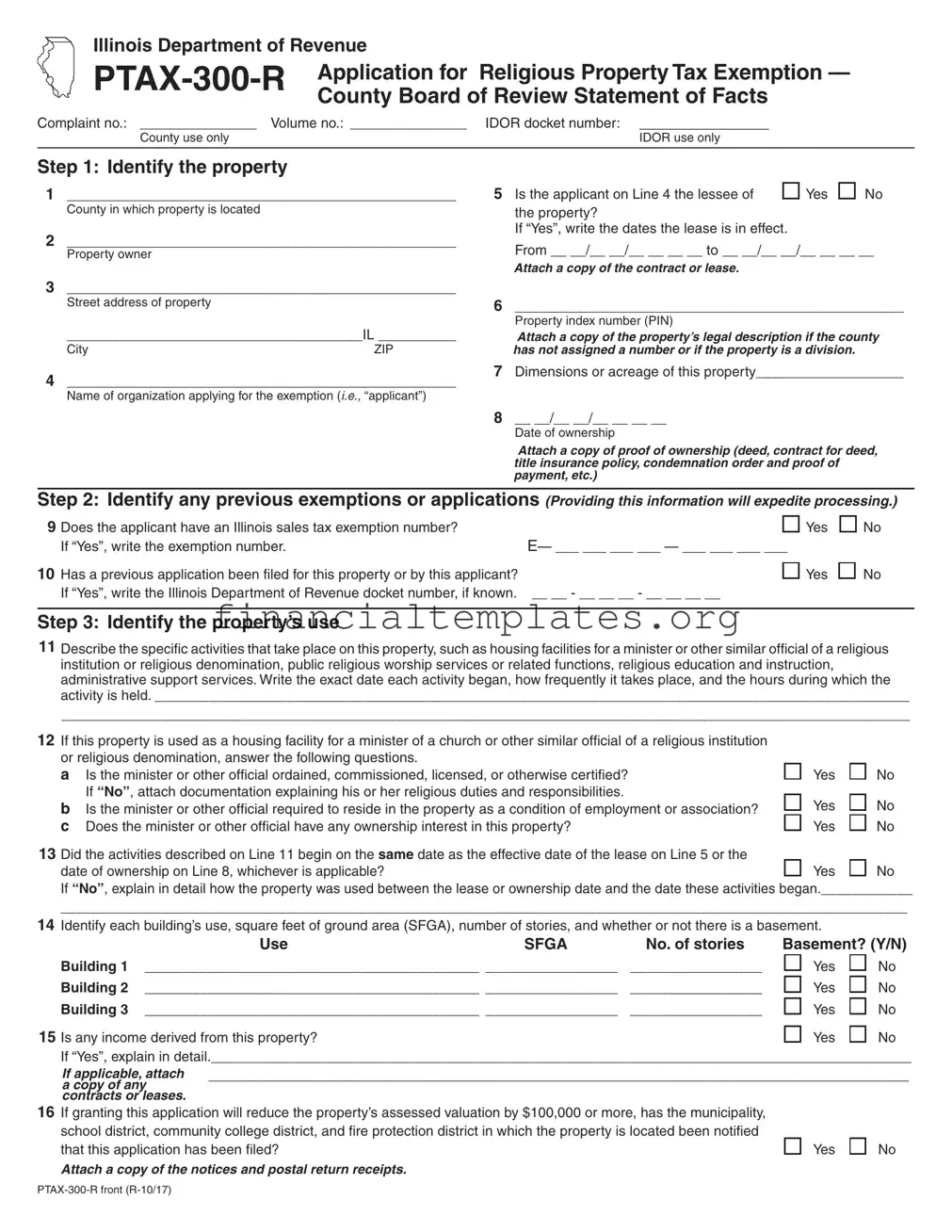When must Form PTAX-300-R be completed?
Complete Form PTAX-300-R to apply for any non-homestead religious exemption.
•For a federal/state agency exemption, complete Form PTAX- 300-FS to apply for a non-homestead exemption under 35 ILCS 200/15-50 or 15-55.
•For any other non-homestead exemption, complete Form PTAX-300 to apply for a non-homestead exemption under 35 ILCS 200/15.
Which steps must the applicant complete?
The applicant must complete Steps 1 through 6. The county board of review must complete Steps 7 and 8.
Complete all lines and attach all required documents or the county board of review will not accept the incomplete exemption application. If there is not enough space on this form to answer a question fully, attach additional sheets. On the top of each ad- ditional sheet, identify the number of each question to which a response is being made.
Note: The Cook County Board of Review requires that their com- plaint form be filed in addition to Form PTAX-300-R.
What must be attached to Form PTAX-300-R?
The following documents must be attached to Form PTAX-300-R:
•Proof of ownership (deed, contract for deed, title insurance policy, copy of the condemnation order and proof of payment, etc.)
•Picture of the property
•Notarized affidavit of use
•Copies of any contracts or leases on the property
To expedite processing, attach additional documents as specified in Step 4.
Must any taxing bodies be notified that an exemption application has been filed?
If granting this application will reduce the property’s assessed valuation by $100,000 or more, the municipality, school district, community college district, and fire protection district in which the property is located must be notified that this application has been filed.
How many forms must be filed if an exemption for multiple parcels is being sought?
File one application in both of the following situations:
•Multiple parcels acquired by the same deed — Form PTAX- 300-R must identify any variation of use or other qualifying information or characteristic (e.g., leases, photos, affidavits of use) by property index number.
•A single parcel that was acquired by multiple deeds.
File a separate application for each parcel if multiple parcels were acquired by separate deeds, unless all four of the following conditions are met:
•The parcels are contiguous.
•All deeds were acquired before the year for which the exemp- tion is now being sought.
•Form PTAX-300-R identifies which property index numbers are associated with each deed.
•Form PTAX-300-R identifies any variation of use, other qualify-
ing information, or characteristic (e.g., leases, photos, affida- vits of use) by parcel identifying number and deed.
Where is Form PTAX-300-R to be filed?
File the completed Form PTAX-300-R with the county board of review. Contact the county board of review where the property is located to determine the filing deadline and session dates.
The county board of review considers exemption applications for the assessment year for which the board is in session only. It cannot consider an exemption for a previous or subsequent as- sessment year.
How is a property’s exempt status determined?
The following text is a brief outline of the procedures used to determine exempt status. For more information, see 35 ILCS 200/15-5 through
15-160, 16-70, 16-130, and the Illinois Administrative Code, Title 86, Chapter 1, Section 110.115, Non-homestead Exemption Proceedings, and Sections 200.101 through 200.225, Practice and Procedure for Hearings Before the Illinois Department of Revenue. Links to these ref- erences are available on the department’s web site at tax.illinois.gov.
Step 1
Obtain Form PTAX-300-R from the county board of review where the property is located. Complete the form, attach all required docu- ments, and file the form with the county board of review.
Step 2
The county board of review may hold a hearing to evaluate the ap- plication and supporting documents.
Step 3
The county board of review completes Steps 7 and 8 and recom- mends whether or not the exemption should be granted before forwarding Form PTAX-300-R and all supporting documents to the department.
Step 4
The department assigns a docket number, reviews the facts regard- ing the application, and determines whether or not the exemption should be granted.
Note: In some instances, the department will request more information from the applicant, who has 30 days from the date of the department’s request to provide that information.
The department mails its decision to
•the applicant,
•any intervenors,
•the county clerk, and
•the clerk of the county board of review.
The department’s decision is final unless the applicant (or another party to the matter) requests a formal hearing.
How is a formal hearing requested if the applicant disagrees with the department’s decision?
Formal hearing requests must be made within 60 days after the date of the department’s decision. Mail requests for a formal hearing to the address provided on the exemption decision. The request will be forwarded to the Administrative Hearings Division.




